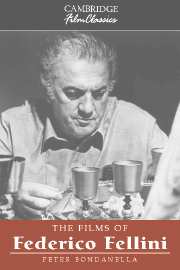Book contents
- Frontmatter
- Contents
- List of Illustrations
- Introduction
- 1 Federico Fellini: A Life in the Cinema
- 2 La strada: The Cinema of Poetry and the Road beyond Neorealism
- 3 La dolce vita: The Art Film Spectacular
- 4 8½: The Celebration of Artistic Creativity
- 5 Amarcord: Nostalgia and Politics
- 6 Intervista: A Summation of a Cinematic Career
- Notes
- Selected Bibliography on Federico Fellini
- A Fellini Filmography: Principal Credits
- List of Additional Films Cited
- Index
3 - La dolce vita: The Art Film Spectacular
Published online by Cambridge University Press: 12 January 2010
- Frontmatter
- Contents
- List of Illustrations
- Introduction
- 1 Federico Fellini: A Life in the Cinema
- 2 La strada: The Cinema of Poetry and the Road beyond Neorealism
- 3 La dolce vita: The Art Film Spectacular
- 4 8½: The Celebration of Artistic Creativity
- 5 Amarcord: Nostalgia and Politics
- 6 Intervista: A Summation of a Cinematic Career
- Notes
- Selected Bibliography on Federico Fellini
- A Fellini Filmography: Principal Credits
- List of Additional Films Cited
- Index
Summary
La dolce vita (1959) represents more than just a significant step in the evolution of Fellini's cinematic style. Like such films in America as Gone with the Wind, Casablanca, or The Godfather, La dolce vita transcended its meaning as a work of art and came to be regarded as a landmark pointing to important changes in Italian society as well. It received the Grand Jury Prize at the Cannes Film Festival, given by a jury that included the French mystery writer Georges Simenon and the American novelist Henry Miller. Its commercial success represented the triumph of the serious art film at the box office, and although it was a relatively expensive film to produce (six hundred million lire), it grossed over 2.2 billion lire in only a few years at a time when tickets in Italy cost only between five hundred and one thousand lire. However, Fellini himself did not become a wealthy man as a result, for as the price of the artistic freedom he required to reconstruct most of the film's sets inside the huge studios of Teatro 5 at Cinecià when he might well have employed on-location shooting throughout the city of Rome, Fellini ultimately renounced the percentage of the profits his original contract specified. Fellini was never much of a businessman, and the loss of a percentage of what became a colossal return would probably not have bothered him a great deal, for his main concern was the film itself. Without the stupendous sets for which Piero Gherardi quite deservedly won an Oscar, La dolce vita would not have been such a smashing hit.
- Type
- Chapter
- Information
- The Films of Federico Fellini , pp. 65 - 92Publisher: Cambridge University PressPrint publication year: 2002



